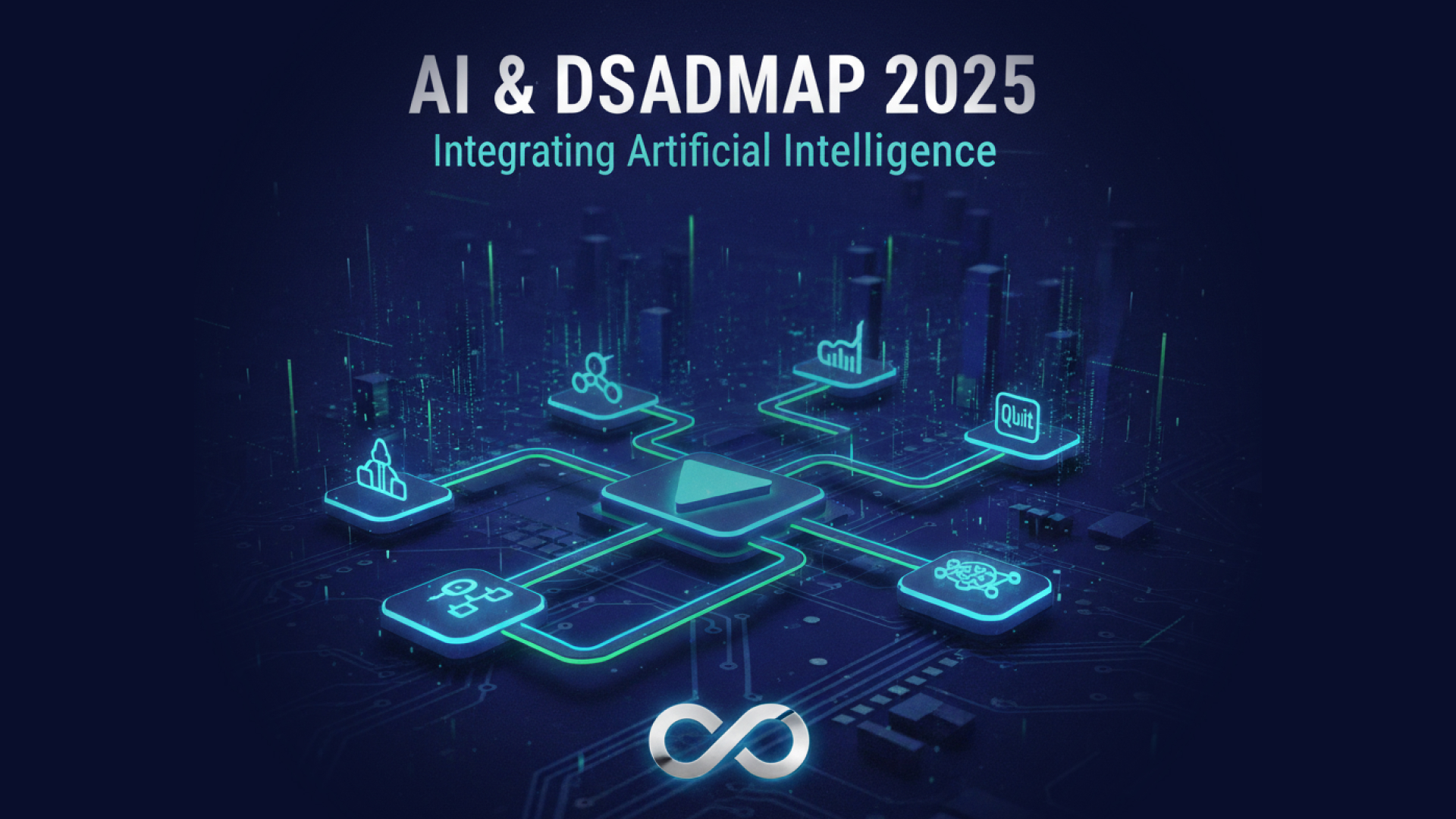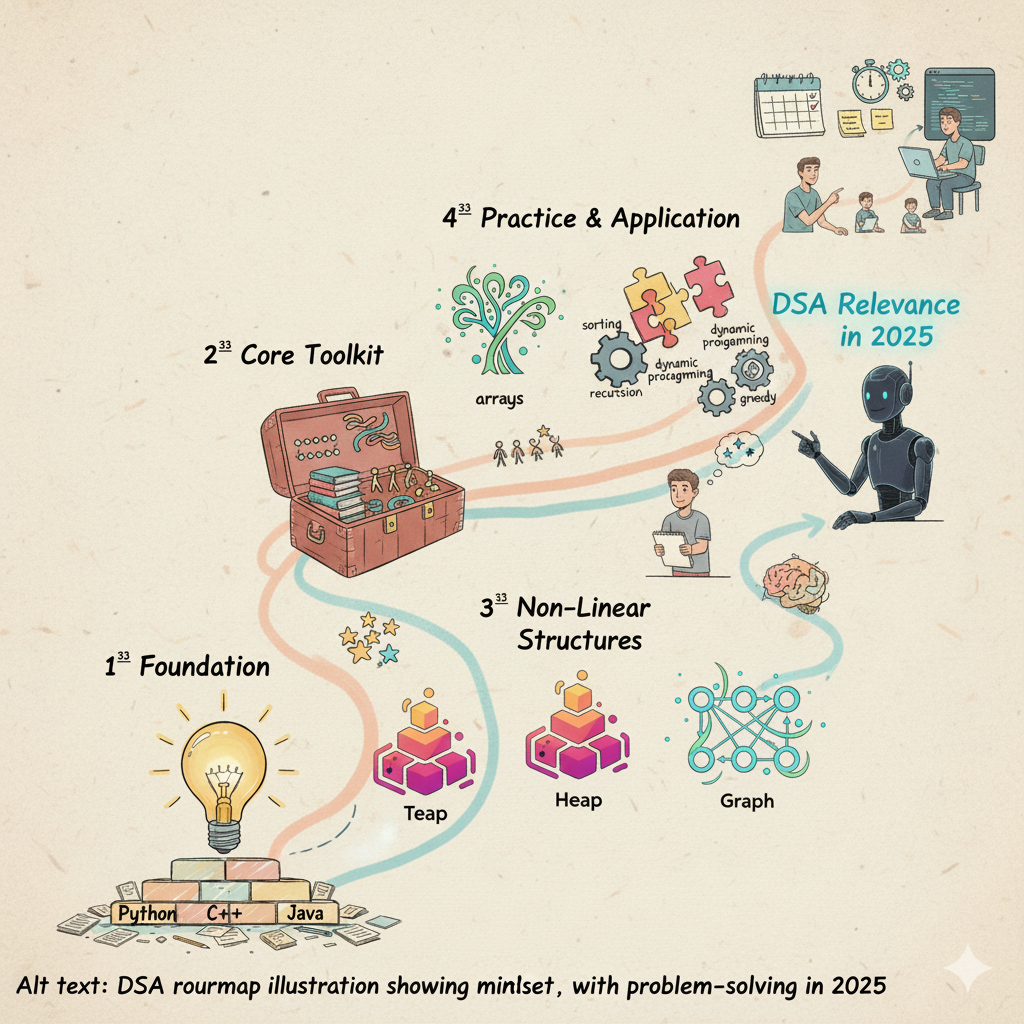Blog

Data Structures and Algorithm Roadmap 2025: What Top Developers Are Learning Right Now
Data Structures And Algorithms Roadmap 2025: What Top Developers Are Learning Right Now
October 28, 2025
Feeling lost on your DSA journey? Our 2025 roadmap breaks down data structures and algorithms into a simple, step-by-step plan. Your path from coding newbie to interview-ready starts here.
.avif)

INTRODUCTION
1. Why Are We Even Talking About Data Structures and Algorithm ?
If you’ve been exploring coding interviews, competitive programming, or even backend and full-stack development, you’ve probably heard one phrase a thousand times: “DSA is a must!”
But here’s the problem, most beginners don’t know where to start, what to focus on, or how much depth is enough.
That’s why this DSA Roadmap for 2025 gives you a clear, step-by-step path that works whether you’re preparing for FAANG interviews, aiming to become a strong developer, or just want to build a problem-solving mindset.

2. Is Data Structure and Algorithm Still Relevant in 2025
What is DSA?
DSA (Data Structures & Algorithms) is the backbone of computer science.
Data Structures are ways of storing and organizing data (like boxes, shelves, or filing cabinets).
Examples: Arrays, Linked Lists, Trees, Graphs.
Algorithms are step-by-step methods for solving problems (like a recipe or a to-do list). Examples: Sorting, Searching, Dynamic Programming.
- Data Structures = How you store information.
- Algorithms = How you process that information efficiently
Imagine you’re building an app like Instagram.
- Without DSA: You just throw data (users, posts, comments) into a messy list. Searching for “user” might take hours because the app doesn’t know where to look.
- With DSA: You use a HashMap (fast lookup) for usernames, a Graph to store follower/following connections, and a Heap to show trending posts. Suddenly, everything works fast even for millions of users.
That’s how DSA works: it makes apps and systems efficient, scalable, and reliable.
And this is why top companies like Google, Amazon, and Microsoft test DSA in interviews. It shows how well you can think logically and solve real-world problems.
3. The Ultimate 5-Step Data Structure and Algorithm Roadmap for 2025

Step 1: Build Your Foundation
- Pick one language → Python, Java, or C++.
- Learn basics: loops, arrays, functions.
- Master Time Complexity & Space Complexity:
Tip: Big-O tells you whether your code will scale for 10 users or 10 million.
Step 2: Core DSA Topics (The Basics You Can’t Skip)
1. Arrays & Strings
Ordered collections of elements (arrays) or characters (strings). Key for problems like reversing, searching, and subarray sums.
2. Linked Lists
Nodes connected in sequence. Efficient for insertion/deletion. Used in reversing lists, detecting cycles, and merging lists.
3. Stacks & Queues
- Stack: LIFO, like a stack of plates. Useful for undo operations and expression evaluation.
- Queue: FIFO, like a ticket line. Useful for scheduling and BFS.
4. Hash Maps / Hash Sets
Store key-value pairs (map) or unique elements (set) for fast lookup. Essential for counting, checking duplicates, and two-sum type problems.
Example Problems:
Implement Stacks, Queues, and Linked Lists from scratch-AI can write it, but writing it yourself helps you understand it.
Step 3: Advanced Structures
- Trees – Hierarchical data structures made of nodes. Binary trees have at most two children per node. Used in searching, traversal, and organizing data efficiently.
- Heaps & Priority Queues – Special tree-based structures. Max-heap/min-heap allows quick access to the largest/smallest element. Priority queues are built on heaps for task scheduling.
- Graphs – Nodes connected by edges. Used to model networks, routes, and relationships. Key algorithms include BFS, DFS, shortest paths, and cycles detection.
Example Problem:
- Number of Islands (Classic graph problem).
This is where most students get stuck-mentorship is sometimes beneficial
Step 4: Algorithms
1. Sorting – Arranging data in a particular order (ascending/descending). Helps in searching, optimization, and organizing information. Visual sorting techniques (like bubble, merge, or quick sort) make it easier to understand how elements move.
2. Searching – Finding an element in a dataset efficiently. Binary search is a fast method for sorted data, repeatedly dividing the search space in half.
3. Recursion & Backtracking – Solving problems by breaking them into smaller subproblems. Backtracking systematically explores all possibilities, used in puzzles, N-Queens, or maze-solving problems.
4. Greedy Algorithms – Making locally optimal choices at each step to find a global solution. Activity selection is a classic example: choosing the maximum number of non-overlapping activities.
Starter Problem: Climbing Stairs (DP)
Once you “see” patterns, DP becomes addictive-it’s like puzzle-solving.
Step 5: Practice the Right Way
How to practice DSA effectively:
- Solve 2–3 problems a day.
- Start easy → medium → hard.
- Revise problems weekly.
- Do mock interviews.
Where to practice:
- LeetCode → Best for interview prep.
- GeeksforGeeks Practice → Topic-wise problems.
- Codeforces → Competitive coding.
- HackerRank → Structured challenges.
4. Beyond the Interview: Applying Your Skills
Mastering DSA independently is challenging. Many developers struggle after basic concepts, becoming overwhelmed by advanced topics. This leads to inconsistent practice, forgotten patterns, and interview panic, making the journey frustrating. Effective guidance is crucial; DSA learning needs deep understanding, strategic problem-solving, and efficient application for interviews. Without a structured approach, months of effort may not lead to interview readiness.
Key benefits of structured guidance include:
- Curated Practice: Not all problems offer equal learning value. Practicing a carefully selected set of problems, accompanied by clear explanations, helps build crucial problem-solving patterns rather than leaving you to guess.
- Mentor Support: The invaluable support of a mentor to review your approaches, correct mistakes, and navigate challenging topics significantly accelerates the learning process.
- Realistic Interview Preparation: Mock interviews and timed problem-solving exercises are vital for building confidence and simulating the pressure of real-world interview scenarios, an experience rarely gained through self-study alone.

📌 If you're serious about getting ready effectively, Meritshot offers curated problem sets + mock interviews so you don’t waste time guessing what to solve.They've got carefully put-together practice problems that hit all the important topics, so you really get it. Plus, beyond just problems, Meritshot also sets up realistic mock interviews. This means you can practice talking and build your confidence in a setting that feels real. By using their stuff, you can stop guessing about how to study and make sure your efforts are going exactly where they'll make the biggest difference. This smart way to prepare helps you learn as much as possible and feel good about going after your goals.
Conclusion: Why DSA Still Matters even with AI

Even with AI like GitHub Copilot, learning Data Structures and Algorithms (DSA) is more important than ever. Here's why:
- Understand the "Why," Not Just the "How": AI writes code, but you understand why one solution is better. You're the architect; AI is just the builder.
- Speak the Language of Problem-Solving: Top companies want to see critical thinking, not just copied code. DSA is the universal language for tackling complex problems.
- Build for Scale: A small script might fail for millions of users. DSA teaches you to write efficient, scalable code that performs under pressure.
Mastering DSA isn't just for interviews; it's about developing a problem-solving mindset and becoming a skilled developer in an AI-driven world. It's the key skill that truly sets you apart.
























